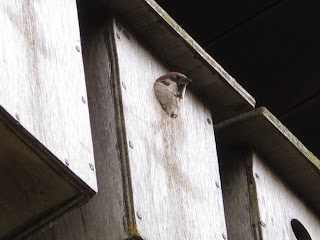I wasn't sure if I would be able count Tree Sparrow as a Hull bird as I started the series, but last week I was very pleased to come across one on the edge of the city at Bransholme. Tree Sparrows differ from House Sparrows by their chestnut brown caps and a black spot on their cheek. They are smaller than House Sparrows and can be shier, keeping to inside bushes and hedgerows, where they can be detected by their call ('tek, tek!'). Male and females look alike. Their favoured habitat are lowland farmland, woodland edges and villages. They are cavity nesters, breeding in holes in trees, hedges or buildings. They readily use nest boxes.
Distribution and status in Hull
In keeping with the national trend, Tree Sparrows are much scarcer in Hull than they used to be, although a few pairs are still clinging on as resident breeding birds at a few locations on the north and east outskirts of the city, where a few visit private gardens.
A record shot of a lone Tree Sparrow by the Beverley and Barmston drain. 6 October 2020, possibly an migrant.
Conservation
Tree sparrows suffered a staggering population decline in the UK: a 95% drop between 1970 and 1998. These populations declines affected the Hull population and are described vividly by Richard Broughton in his 'Birds of the Hull Area". Since then, the population has been stable or increasing, but records in the Hull area have been very scarce, with apparent loses of known colonies (Snuff Mill Lane, Noddle Hill LNR), although sizeable winter flocks have been recorded in recent years according to BTO Birdtrack records, eg. 90 in January 2016 at and 50 in December 2014 at Castle Hill area; 30 in September 2018 at Priory Road; 30 in November 2020). The BTOs Breeding Bird survey shows that population size tripled in Yorkshire and the Humber from 1994 to 2019, but starting from very low levels. They are in the The Birds of Conservation Concern 5 Red list and have a UK and Hull Biodiversity Action plan. Their population declines appear to respond to changes during winter, probably due to lack of food as agricultural practices changed and intensified as with other farmland birds. The loss of winter stubbles, field margins and wetlands are also linked to their decline.Tree Sparrows respond very well to conservation practices. They are thriving in local nature reserves (North Cave Wetlands, Bempton Cliffs) providing them with nest boxes and supplementary winter food. They are a very social species, so several nest boxes can be placed together. Encouraging members of the public and local farmers to install next boxes and feed Tree Sparrows in the winter near existing colonies might aid with the recovery of the Hull population.
More information
BTO Birdfacts Tree Sparrow.
Operation Tree Sparrow. RSPB website.
Broughton, Richard K. Birds of the Hull Area.






No comments:
Post a Comment